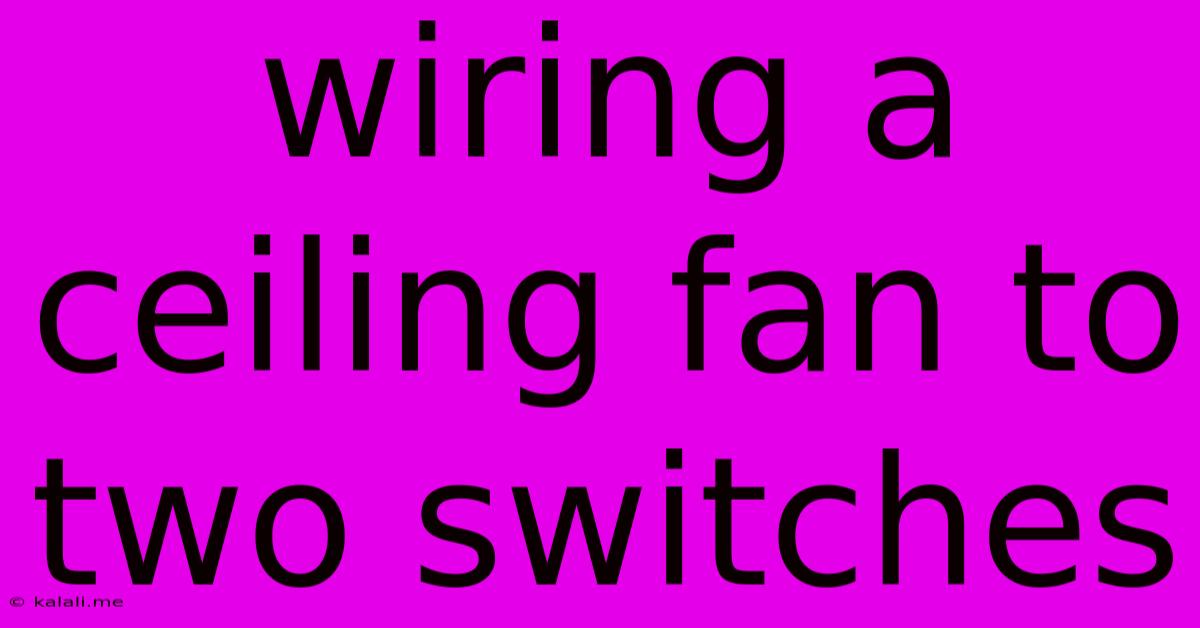Wiring A Ceiling Fan To Two Switches
Kalali
May 31, 2025 · 4 min read

Table of Contents
Wiring a Ceiling Fan to Two Switches: A Complete Guide
Meta Description: Learn how to wire a ceiling fan to two switches for convenient control from two different locations in your home. This comprehensive guide provides step-by-step instructions and safety tips for a successful installation.
Controlling your ceiling fan from two different locations adds a level of convenience and luxury to your home. Whether you want to turn it on from your bed or from the doorway, wiring a ceiling fan to a three-way switch setup is a worthwhile upgrade. This guide will walk you through the process, providing clear instructions and important safety precautions. While it might seem daunting, with careful planning and attention to detail, this project is achievable for many DIY enthusiasts.
Understanding Three-Way Switching
Before diving into the wiring, let's understand the fundamentals. A standard light switch controls a light from one location. To control a light or fan from two different locations, you need a three-way switch system. This system uses two three-way switches (not to be confused with single-pole switches) and specific wiring to allow for independent control. Each three-way switch has three terminals:
- Common: This terminal connects to the power source and the other three-way switch.
- Traveler 1: This terminal connects to the Traveler 1 terminal on the other three-way switch.
- Traveler 2: This terminal connects to the Traveler 2 terminal on the other three-way switch.
Tools and Materials You'll Need
Before you begin, gather all necessary tools and materials. This will ensure a smooth and efficient installation.
- Three-way switches (2): Make sure these are rated for the amperage of your ceiling fan.
- Electrical tape: For secure connections.
- Wire strippers/cutters: To properly prepare the wires.
- Voltage tester: Essential for safety; always check for power before starting.
- Screwdrivers (Phillips and flathead): For removing and installing switches and fan parts.
- Wire nuts: To connect the wires securely.
- Ceiling fan: Make sure it’s compatible with three-way switching. Many modern fans are designed for this.
- Electrical box: The junction box where the wires will be connected.
Step-by-Step Wiring Instructions
1. Safety First: Turn off the power at the breaker box before starting any wiring. Double-check with a voltage tester to confirm the power is off.
2. Prepare the Wires: Carefully strip the insulation from the ends of all your wires (black, white, ground). Make sure you leave enough exposed wire for secure connections.
3. Wire the Switches: Refer to your switch's wiring diagram (usually found on the switch itself). Connect the wires as follows:
-
Switch 1: Connect the incoming hot wire (usually black) to the common terminal. Connect the remaining two wires (travelers) to the Traveler 1 and Traveler 2 terminals.
-
Switch 2: Connect the outgoing hot wire (usually black, going to the fan) to the common terminal. Connect the traveler wires to the corresponding Traveler 1 and Traveler 2 terminals.
-
Neutral Wire: Connect the neutral wires (usually white) from both switches together using a wire nut.
-
Ground Wires: Connect all ground wires (usually bare copper or green) together using a wire nut.
4. Wiring the Ceiling Fan: Connect the wires from the switches to the ceiling fan's wiring compartment. The fan wiring will typically have wires for hot, neutral, and ground connections. Ensure you match the correct wires from the switches to the corresponding wires on the fan. Refer to the fan's installation manual for precise wiring instructions.
5. Secure Connections: Ensure all wire nut connections are tight and secure. Use electrical tape to further secure the connections, especially if there is any slack in the wires.
6. Mount the Switches and Fan: Carefully mount the switches in their designated wall boxes and securely attach the ceiling fan to the ceiling electrical box.
7. Restore Power: Turn the power back on at the breaker box.
8. Test the System: Test the functionality of both switches to ensure the fan operates correctly from both locations.
Troubleshooting Tips
- Fan doesn't work: Double-check all wire connections and ensure the power is correctly restored at the breaker.
- Switch malfunctions: Inspect the switches for loose connections or damaged parts.
- One switch doesn't work: Verify all wiring connections between the two switches and the fan.
This detailed guide provides a comprehensive understanding of wiring a ceiling fan to two switches. Remember, electrical work can be dangerous. If you are not comfortable with electrical wiring, consult a qualified electrician. Always prioritize safety and double-check all connections before restoring power. With careful attention to detail and adherence to safety regulations, you can successfully complete this project and enjoy the added convenience of controlling your ceiling fan from two locations.
Latest Posts
Latest Posts
-
How Often Should I Cut Bunnys Nail
Jun 01, 2025
-
What Is The Little Window In A Door Called
Jun 01, 2025
-
Like Some Gods In The Marvel Universe
Jun 01, 2025
-
How To See If Someone Checked Into Their Flight
Jun 01, 2025
-
Can You Add Marshmallows To Brownie Mix
Jun 01, 2025
Related Post
Thank you for visiting our website which covers about Wiring A Ceiling Fan To Two Switches . We hope the information provided has been useful to you. Feel free to contact us if you have any questions or need further assistance. See you next time and don't miss to bookmark.